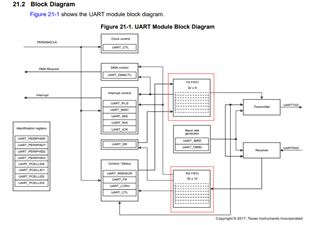Other Parts Discussed in Thread: CC1312R
I have a Raspberry PI sending ASCII data to the CC1312R at 921600 baud. I often received
corrupted data (about 10%). I don't see problem between 2 Raspberry PI's. So there might
be issues with the configuration on the CC1312R side. I am not familiar with UART settings
on the board. I used these basic settings;
UART_Params_init(&uartParams);
uartParams.writeDataMode = UART_DATA_BINARY;
uartParams.readDataMode = UART_DATA_BINARY;
uartParams.readReturnMode = UART_RETURN_FULL;
uartParams.readTimeout = UART_WAIT_FOREVER;
uartParams.writeTimeout = UART_WAIT_FOREVER;
uartParams.baudRate = 921600;
I have configured the UART RingBuffer size to 4096
and UART FIFO to 1024. I am writing and reading packets of 96 bytes. I have not been able to elminate
the corrupted data entirely. Are there parameters I need to set to make it right?
TW


